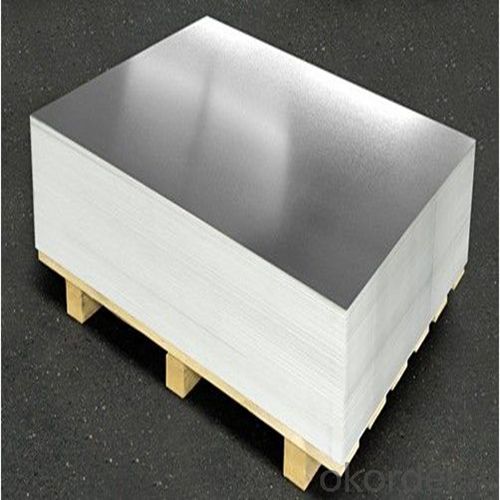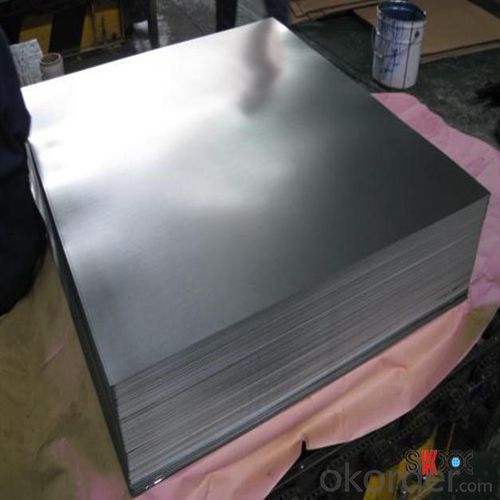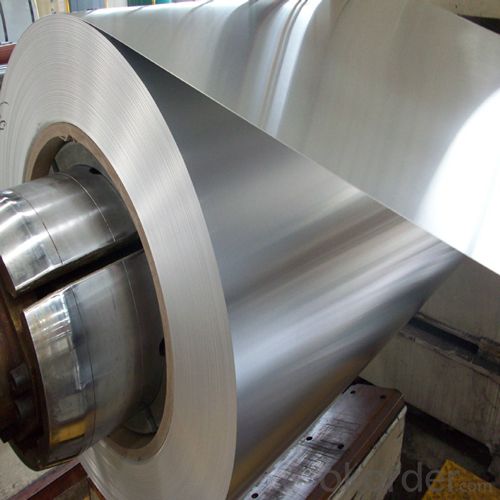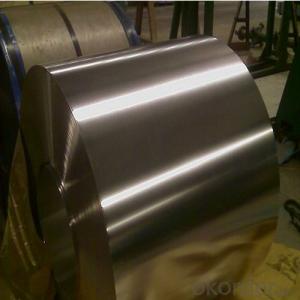Electrolytic Tinning Plate for Can Making in High Quality
- Loading Port:
- Tianjin
- Payment Terms:
- TT OR LC
- Min Order Qty:
- 25 unit
- Supply Capability:
- 7000 unit/month
OKorder Service Pledge
OKorder Financial Service
You Might Also Like
1.Structure of Electrolytic Tinning Plate for Can Making in High Quality Description
Electrolytic Tin Plate Coils and Sheets for Foods Metal Packaging, is one thin steel sheet with a coating of tin applied by electrolytic deposition. Tinplate made by this process is essentially a sandwich in which the central core is strip steel. This core is cleaned in a pickling solution and then fed through tanks containing electrolyte, where tin is deposited on both sides. As the strip passes between high-frequency electric induction coils, it is heated so that the tin coating melts and flows to form a lustrous coat.
2.Main Features of the Electrolytic Tinning Plate for Can Making in High Quality
Appearance – Electrolytic Tin Plate is characterized by its beautiful metallic luster. Products with various kinds of surface roughness are produced by selecting the surface finish of the substrate steel sheet.
Paintability and printability – Electrolytic Tin Plates have excellent paintability and printability. Printing is beautifully finished using various lacquers and inks.
Formability and strength – Electrolytic Tin Plates have got very good formability and strength. By selecting a proper temper grade, appropriate formability is obtained for different applications as well as the required strength after forming.
Corrosion resistance – Tinplate has got good corrosion resistance. By selecting a proper coating weight, appropriate corrosion resistance is obtained against container contents. Coated items should meet 24 hour 5 % salt spray requirement.
Solderability and weldability – Electrolytic Tin Plates can be joined both by soldering or welding. These properties of tinplate are used for making various types of cans.
Hygienic – Tin coating provides good and non toxic barrier properties to protect food products from impurities, bacteria, moisture, light and odours.
Safe – Tinplate being low weight and high strength makes food cans easy to ship and transport.
Eco friendly – Tinplate offers 100 % recyclability.
Tin is not good for low temperature applications since it changes structure and loses adhesion when exposed to temperatures below – 40 deg C.
3.Electrolytic Tinning Plate for Can Making in High Quality Images



4.Electrolytic Tinning Plate for Can Making in High Quality Specification
Standard | ISO 11949 -1995, GB/T2520-2000,JIS G3303,ASTM A623, BS EN 10202
|
Material | MR,SPCC |
Thickness | 0.15mm - 0.50mm |
Width | 600mm -1150mm |
Temper | T1-T5 |
Annealing | BA & CA |
Coil Inner Diameter | 508mm |
Weight | 6-10 tons/coil 1~1.7 tons/sheets bundle |
Passivation | 311 |
Oil | DOS |
Surface | Finish,bright,stone,matte,silver |
5.FAQ of Electrolytic Tinning Plate for Can Making in High Quality
-How to place .an order or contact you ?
Please send us Email. we will give you a quick response in seconds .
- How is your quality ?
All our quality is prime even the secondary quality . We have many years experience
In this field with serious quality control standard . Advanced equipment, We welcome your visit to our factory .
- Q:How is tinplate protected during transportation and storage?
- Tinplate is typically protected during transportation and storage through various measures such as applying a protective coating, using appropriate packaging materials, and implementing suitable handling and stacking procedures. The protective coating, often a thin layer of oil or lacquer, helps to prevent corrosion and maintain the integrity of the tinplate. Additionally, packaging materials like plastic wraps, paper interleaves, or cardboard dividers are used to separate and cushion the tinplate sheets, preventing scratches, dents, or other damages. Proper handling techniques, including careful loading and unloading, as well as appropriate stacking methods, ensure that the tinplate remains stable and secure during transportation and storage, reducing the likelihood of any physical harm.
- Q:What are the advantages of using tinplate for signage?
- There are several advantages of using tinplate for signage. Firstly, tinplate is highly durable and long-lasting, making it ideal for outdoor signage that needs to withstand various weather conditions. Additionally, tinplate is resistant to corrosion, reducing the risk of the signage deteriorating over time. Furthermore, tinplate can be easily shaped and molded into various designs, allowing for creative and eye-catching signage. Lastly, tinplate is cost-effective compared to other materials used for signage, making it an affordable option for businesses.
- Q:What are the main export markets for tinplate?
- The main export markets for tinplate include countries such as China, Japan, South Korea, United States, and Germany.
- Q:What are the main suppliers of tinplate?
- The main suppliers of tinplate are usually large steel manufacturing companies that have the capability to produce and coat steel sheets with a thin layer of tin. Some prominent suppliers include companies like ArcelorMittal, Nippon Steel Corporation, Tata Steel, and POSCO.
- Q:Can tinplate be used for aerosol packaging?
- Yes, tinplate can be used for aerosol packaging. Tinplate is a commonly used material for aerosol cans due to its excellent strength, durability, and resistance to corrosion. It provides an effective barrier against moisture and oxygen, ensuring the integrity and longevity of the aerosol product. Additionally, tinplate is easily recyclable, making it an environmentally friendly choice for aerosol packaging.
- Q:What are the common storage and handling requirements for tinplate?
- Common storage and handling requirements for tinplate include storing it in a dry and well-ventilated area, away from moisture and direct sunlight. It should be kept in a temperature-controlled environment to prevent any damage or corrosion. Proper handling techniques, such as using gloves and avoiding sharp objects, should be followed to prevent any surface scratches or dents. Tinplate should also be stacked and stored in a way that prevents any deformation or structural damage.
- Q:How does tinplate affect the overall cost of packaging?
- Tinplate can have a significant impact on the overall cost of packaging. While tinplate is known for its durability and ability to protect products, it is often more expensive than other packaging materials such as plastic or cardboard. The cost of tinplate includes not only the material itself but also the manufacturing process, transportation, and any additional coatings or finishes. Therefore, the decision to use tinplate for packaging should be carefully considered, weighing its benefits against its higher cost.
- Q:How does tinplate contribute to the preservation of paint products?
- Tinplate contributes to the preservation of paint products by providing a durable and protective packaging material. Its corrosion-resistant properties prevent the paint from coming into contact with air and moisture, which can degrade its quality over time. Additionally, tinplate's ability to withstand high temperatures and impacts ensures that the paint remains intact during transport and storage, maintaining its freshness and longevity.
- Q:What are the main applications of tinplate in the aerosol industry?
- Tinplate is extensively used in the aerosol industry due to its excellent corrosion resistance properties and ability to withstand high pressure. Its main applications in this industry include aerosol can bodies and closures, ensuring the safe storage and transportation of products such as deodorants, hairsprays, and air fresheners.
- Q:What are the challenges in manufacturing tinplate?
- Some of the challenges in manufacturing tinplate include ensuring the uniformity of tin coating on the steel base, preventing corrosion during storage and transportation, maintaining the dimensional accuracy of the tinplate sheets, and addressing environmental concerns related to the disposal of tin and tin-containing wastewater. Additionally, meeting the specific quality requirements of different industries and managing the cost of production can also be challenging in tinplate manufacturing.
1. Manufacturer Overview |
|
|---|---|
| Location | |
| Year Established | |
| Annual Output Value | |
| Main Markets | |
| Company Certifications | |
2. Manufacturer Certificates |
|
|---|---|
| a) Certification Name | |
| Range | |
| Reference | |
| Validity Period | |
3. Manufacturer Capability |
|
|---|---|
| a)Trade Capacity | |
| Nearest Port | |
| Export Percentage | |
| No.of Employees in Trade Department | |
| Language Spoken: | |
| b)Factory Information | |
| Factory Size: | |
| No. of Production Lines | |
| Contract Manufacturing | |
| Product Price Range | |
Send your message to us
Electrolytic Tinning Plate for Can Making in High Quality
- Loading Port:
- Tianjin
- Payment Terms:
- TT OR LC
- Min Order Qty:
- 25 unit
- Supply Capability:
- 7000 unit/month
OKorder Service Pledge
OKorder Financial Service
Similar products
New products
Hot products
Related keywords



























